Europe doesn’t get more far-flung, or magical, than this breathtaking place
“Do you see the black house over there? The one with the green roof, next to the yellow house?” asks Hanus Hojgaard, our Faroese guide, as we round a bend and spy a cluster of brightly painted timber-clad homes sprinkling the grassy slopes above the ocean. “That’s where I grew up; where I was born, in fact,” says Hanus, recalling his upbringing in this sleepy clifftop village called Rituvik, where his mother was also raised, one of 12 siblings whose collective longevity briefly put them in the Guinness World Records.
“It was a combined 1067 years before the first one died,” says Hanus, as my gaze drifts from the red and yellow benches in the garden of his two-storey birthplace to the blues of the sky and the North Atlantic behind the hedges. Beguiled by this absurdly idyllic setting, I wonder out loud if Hanus, now in his early 60s, still lives here: “No, but we own it,” he says. “It’s a great place to be in the summer. It’s on Airbnb: ‘House with a view’.”
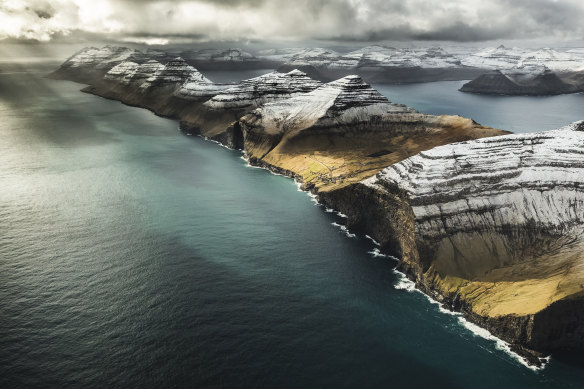
European destinations don’t get much more far-flung than the Faroe Islands, between Britain and Iceland.Credit: visitfaroeislands.com
A quick look online and I see it’s booked out for the next three months. But we don’t need a bed for the night. We’re visiting the Faroe Islands on a new expedition cruise with Ponant, a luxury French company that specialises in exotic, far-flung destinations. And in Europe, there are few place more far-flung than the Faroes.
Created by volcanic eruptions about 55 million years ago, and subsequently eroded by glaciers, winds and waves, this dreamlike archipelago sprouts almost halfway between Iceland and Britain, whose northern tip is about 300 kilometres away as the gull flies (or indeed the puffin, razorbill, guillemot or some of the other breeding seabirds we glimpse on this May cruise, which begins and ends in Glasgow, taking in myriad majestic Scottish islands en route).
We soak up more Faroese history, nature and fairytales on our excursion with Hanus, who’d met us at the port of Runavik, the largest settlement on Eysturoy (East Island), one of 18 major islands comprising this self-governing nation, which is part of the Kingdom of Denmark (1100 kilometres away). Initially, we travel by coach alongside the longest and most dramatic fjord of these islands, and I find myself admiring both the scenery and the cardigan donned by the young man at the wheel. Knitted patterned cardies and sweaters are a popular Faroese export – remember the one worn by Sofie Grabol (as cop Sarah Lund) in Nordic noir drama The Killing?
The wool is sheared from the fluffy animals roaming an archipelago that translates to “sheep islands” in Faroese, a language said to be more closely related to Icelandic and Norwegian than Danish. Its linguistic roots come from the Vikings, those hardy seafarers who were the first to officially settle these islands in the ninth century (recent archaeological studies, however, claim Irish monks may have lived here hundreds of years earlier).
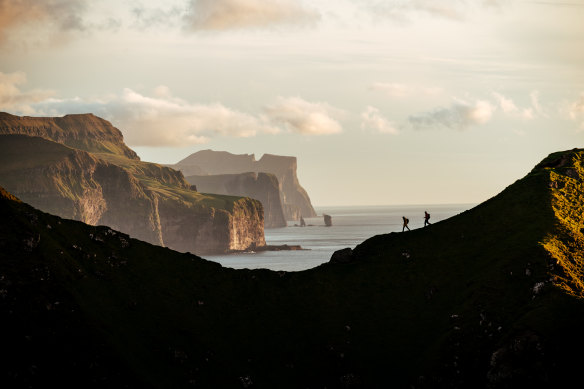
Created by volcanic eruptions about 55 million years ago, and subsequently eroded by glaciers, winds and waves, this dreamlike archipelago sprouts almost halfway between Iceland and Britain.Credit: Chris Riefenberg/visitfaroeislands.com
Today the Faroes have more sheep than people – roughly 80,000 versus 55,000 – and we pass adorable newborn lambs nibbling at grassy roadside verges and more as we swap the coach for an hour-long mountain hike between the sleepier-than-sleepy hamlets of Ness and Aeduvik. Spanning a heel-shaped peninsula, the vaguely thigh-straining path takes us away from the fjord, through stream-carved, peat-blanketed moorland that’s squishy underfoot.
“We’re fortunate with the weather,” says Hanus, his eyes squinting at the sunshine. Apparently it rains here about 300 days a year. Sometimes fog sweeps in, slashing visibility, making the regular trail markers a godsend.
Particularly striking are the cairns – cone-shaped piles of boulders dripping with mythology and folklore. Some say you should never move them lest you anger the islands’ ancient trolls. But the cairns have been enhanced recently as part of a restoration project to mend neglected paths, gates and stiles. Colour-coded signposts have been hammered in too, many by so-called “voluntourists” invited here by the Faroese government – including some from Australia. While they must pay for their flights, volunteers are given free lodging and food in return for a few days’ toil. Most, you suspect, go home raving about the magical landscapes and pure air they’ve walked and worked in.
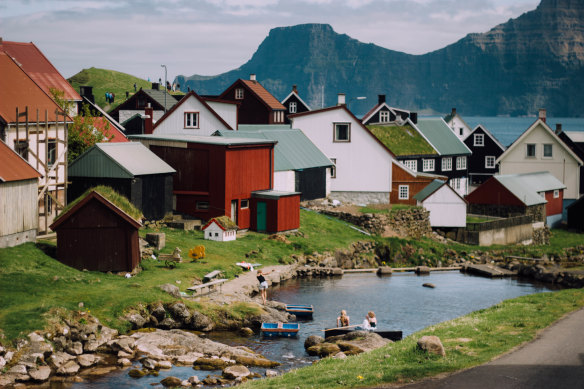
Visitors are scarce in the Faroes.Credit: visitfaroeislands.com
Compared to Iceland, visitors are scarce here, helped by the relatively tiny number of international flights and cruise ships. Tourism accounts for a fraction of the GDP, overshadowed by industries like fishing, farming, financial services and IT (Hanus is a computer programmer by trade and a tour guide on the side). Time, effort and money are required to come to the Faroes, but chances are you’ll be blown away – and we’re not talking about those 250km/h gusts that can occasionally rip through.
The next morning, I step out onto my cabin balcony and watch fulmars cackling by sheer cliffs, outcrops and sea stacks jutting towards a cloudless sky. We were supposed to spend today exploring Suduroy (South Island), but a public-sector strike – the biggest here for two decades, affecting everyone from port workers to bus drivers – forced a rethink from Mickael Debien, likeable captain of our sleek, nimble ship, Le Boreal. Which is how we’ve ended up here, anchored off Vagar, the most westerly of the large Faroe Islands.
One of the most enjoyable aspects of this cruise – beyond the cuisine, which is worth a thesis in itself – are the encounters with Ponant’s team of on-board naturalists. Containing both generalists and experts in subjects like geology, biology and oceanography, they host daily themed lectures in the ship’s theatre – such as on the grindadrap, the Faroes’ controversial heritage of pilot whale hunting. Naturalists also lead expeditions on Zodiac boats and dry land. Like everything on this cruise, it’s all explained in French and English.
Post-breakfast, we’re buzzed over by Zodiac to be dwarfed by Vagar’s magnificent, grass-streaked cliffs, which are gouged with caves, including one etched like a super-sized shard of glass. Gliding into this eerily atmospheric portal, I imagine a Bond villain’s lair lurking behind the rocks. The Frenchman beside me reckons it’s like a scene from a Jules Verne novel.
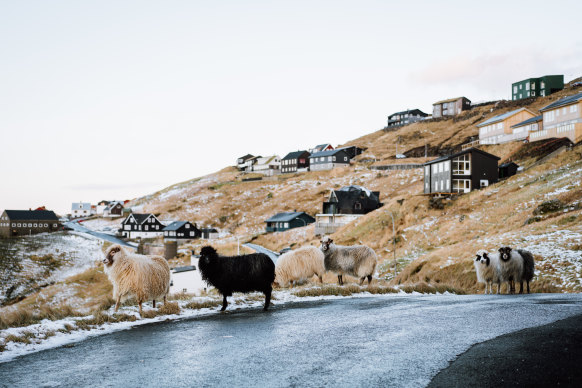
There are more sheep than humans in the Faroes.Credit: Ingrid Hofstra/visitfaroeislands.com
After returning to the ship for lunch – sauteed squid and slowly braised beef cheek for me – we’re soon out on the Zodiacs again, jumping off at a pebble-strewn beach where naturalist Christian, armed with camera and binoculars, alerts us to fulmars nesting in the pockmarked cliffs. Further along, a waterfall crashes onto the beach and there’s another cascade at our next stop, Bour, a coastal village with 71 residents and fairytale-esque houses – half capped with traditional turf roofs – huddled by a 19th-century church.
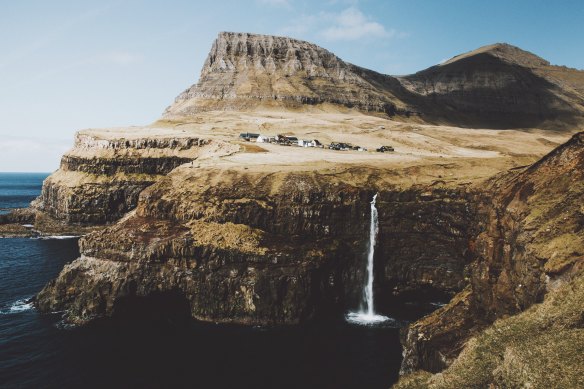
Dramatic: Vagar Island.Credit: Daniel Casson/visitfaroeislands.com
It’s 14 degrees – close to the average daytime summer temperature – and adults are nursing coffees on the suntrap terrace of the village cafe, while a boy kicks a football on the black-sand beach below. We get chatting to a cheerful woman and her granddaughter who’ve driven here from Torshavn, the Faroese capital (population 14,000, 45 minutes away by car). “It’s foggy there,” says the grinning grandma, as the little girl trots down to the shore with her bucket and spade.
Bidding them – and the Faroe Islands – farewell, we Zodiac it back to Le Boreal, where the patissier greets us with fabulously flaky slices of walnut mille-feuille and captain Mickael announces that, after “a beautiful day, beautiful place, beautiful weather”, we’ll be setting sail for Scotland.
Five more things to know about the Faroe Islands
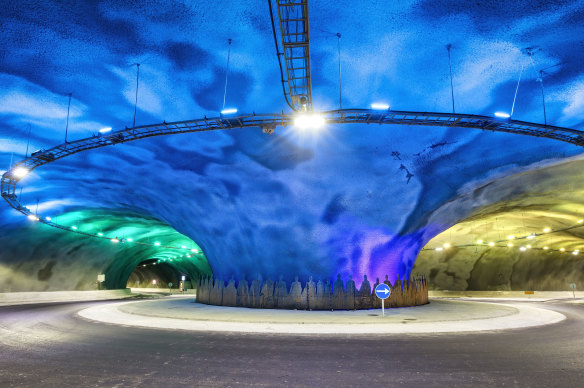
Eysturoyartunnilin boasts the world’s first undersea roundabout.Credit: Olavur Frederiksen/Faroephoto.com
TUNNELS Ferries connect the archipelago, but more inter-island journeys are now done via road tunnels, including Eysturoyartunnilin, completed in 2020 and boasting the world’s first undersea roundabout.
CLIMATE The Faroe Islands sit at 62 degrees north, higher in latitude than St Petersburg (Russia) and Edmonton (Alberta), but with milder winters thanks to the warming gulf stream.
POLITICS Unlike Denmark, the Faroe Islands declined to join the then-European Economic Community in 1973, and remain separate to the European Union.
SIZE At just 1400 square kilometres in land mass (smaller than Greater London), the Faroe Islands boast 247,000 square kilometres of marine area (about the size of the whole UK). Fish and seafood form a big part of the nation’s diet, along with root vegetables and delicacies like fermented mutton.
SOUVENIRS Whether purchasing wool sweaters or fridge magnets starring oystercatchers (the national bird), you’ll pay in Faroese krona – a currency pegged one-to-one with the Danish krone.
THE DETAILS
CRUISE
Ponant’s nine-night Scottish archipelagos and the Faroe Islands: Nordic heritage and island identities cruise departs Glasgow on May 21, 2025. It’s priced from $10,420 per person, with your fare including everything from on-board dining and drinks to expeditions and excursions. See au.ponant.com
FLY
Emirates flies to Glasgow from Sydney and Melbourne. See emirates.com
The writer travelled as a guest of Ponant
Sign up for the Traveller Deals newsletter
Get exclusive travel deals delivered straight to your inbox. Sign up now.